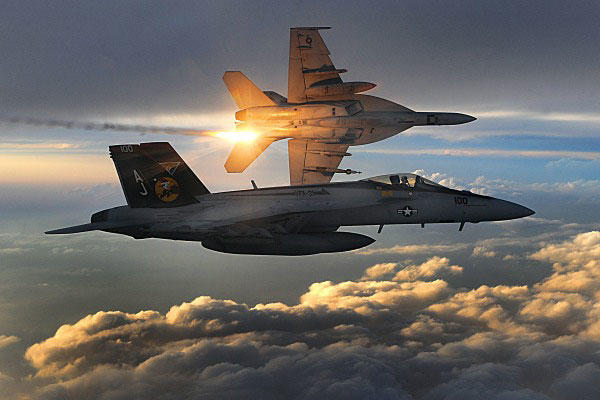FARNBOROUGH, England -- The Navy recently conducted several ground and airborne tests of stealth-enhancing upgrades to the F/A-18 Super Hornet in an effort to improve the fighter aircraft's ability to elude radar detection, service leaders said.
"The point of putting on a conformal fuel tank and the point of the external weapons pod would be to carry fuel and weapons in a way so as not to increase the signature of the airplane," said Capt. Frank Morley, F/A-18 and EA-18G program manager.
Working in tandem with F-18-maker Boeing, the Navy conducted a series of ground assessments and flight test to see how these modifications improved the stealth-like characteristics of the aircraft. The tests occurred as the F-35 continues to face problems with the recent grounding and Boeing officials lobby the Navy to buy more F/A-18s as a backstop for F-35 problems.
Supporters of the F-35 often counter Boeing's lobbying efforts saying the F/A-18's lack of stealth would make it useless in a war against an enemy like Russia, China, or Syria that bolster advanced air defense systems.
Morley said the ground and air assessments successfully demonstrated that the change to the aircraft resulted in a reduced radar signature. He indicated that some specifics regarding the assessments of low-signature technology were not publically available.
"We were pleased with the results," he added.
The conformal fuel tanks are aerodynamically designed to help the F/A-18 have a lower detectability or signature. Boeing officials have said the conformal fuel tanks reduce the signature of the aircraft by over 50 percent.
Aerodynamically configured conformal fuel tanks are engineered to carry up to 3,500 pounds of fuel, Boeing officials said. In addition to helping to reduce the signature, the conformal fuel tank and external weapons pod are engineered to help make the aircraft able to fly further with more weapons without increasing signature or drag for the airplane, Navy officials said.
The external weapons pod -- as opposed to using pylons to carry the weapons -- could lead to greater use of air-to-air missiles as well as air-to-ground bombs. The enclosed, external aerodynamically engineered weapons pod is built to carry up to 2,500-pounds of weapons.
The Super Hornet is configured to fire the AIM-9X Sidewinder air-to-air missile, the AIM-120 Advanced Medium Range Air-to-Air Missile, or AMRAAM, the Joint Standoff Weapon, the Small Diameter Bomb and the Mk-84 general purpose bomb, among others.
These upgrades are needed because F/A-18 aircraft are expected to serve well into the 2030's, Morley added.
So far, the Navy, Boeing and its partners have built and delivered more than 487 F/A-18E/F on their way to a program goal of 563 aircraft, Navy officials said.
The current Block II configuration of the F/A-18 Super Hornet, which first deployed in 2008, was engineered with a host of signature-reducing and endurance enhancing modifications compared to prior models of the aircraft.
Some of the enhancements include the use of Active Electronically Scanned Array, or AESA, radar, "jamming" decoys and an integrated electronic countermeasures system. The countermeasures system consists of three main components; they include and on-board jammer, visually cued radar warning receiver and a decoy, according to Navy officials.
-- Kris Osborn can be reached at kris.osborn@monster.com



























